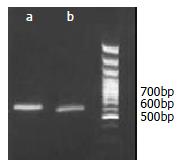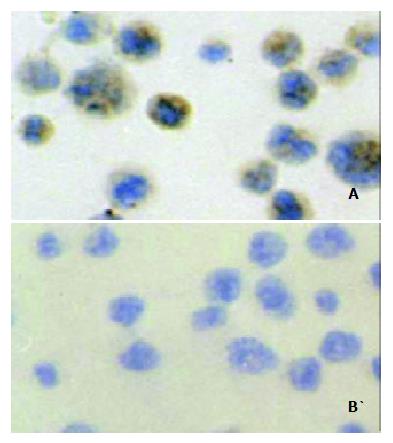Copyright
©The Author(s) 2003.
World J Gastroenterol. Jun 15, 2003; 9(6): 1191-1195
Published online Jun 15, 2003. doi: 10.3748/wjg.v9.i6.1191
Published online Jun 15, 2003. doi: 10.3748/wjg.v9.i6.1191
Figure 1 Incorporation of the epitope gene into the pcDNA3.
1 fragment by PCR: A product of 620bp was amplified by the first PCR (a), and a fragment of 660bp was amplified by the second PCR (b).
Figure 2 Hind III digestion of the recombinant plasmid after subcloning the PCR product into pcDNA3.
1 (+) from the pUCm-T vector: A fragment of 660bp was released (c), which corresponded to the size of the carrier fragment.
Figure 3 Sequencing of PCR product (partial sequence): By PCR, the two epitopes were fused together and incorporated into a pcDNA3.
1 fragment. The amino acid sequence of KPHVHTKGGGS correspondeds to the sequence of MG7-Ag mimotope. AKFVAAWTLKAAZ corresponds to the sequence of universal Th epitope PADRE.
Figure 4 PCR identification of the pcDNA3.
1 (+)-MG7/PADRE plasmid harbored by the Salmonella typhimurium SL3261: By PCR, a fragment of 800bp was amplified (d), suggesting the existence of epitope genes and removal of carrier fragment.
Figure 5 Immunohistochemical staining of the Ehrlich ascites carcinoma cells (EAC): Positive signal was seen in the cytoplasm and membrane of the EAC cells (A).
When stained with a negative control monoclonal antibody (anti-E-tag antibody), the EAC cells showed no positive staining (B).
-
Citation: Guo CC, Ding J, Pan BR, Yu ZC, Han QL, Meng FP, Liu N, Fan DM. Development of an oral DNA vaccine against MG7-Ag of gastric cancer using attenuated
salmonella typhimurium as carrier. World J Gastroenterol 2003; 9(6): 1191-1195 - URL: https://www.wjgnet.com/1007-9327/full/v9/i6/1191.htm
- DOI: https://dx.doi.org/10.3748/wjg.v9.i6.1191













